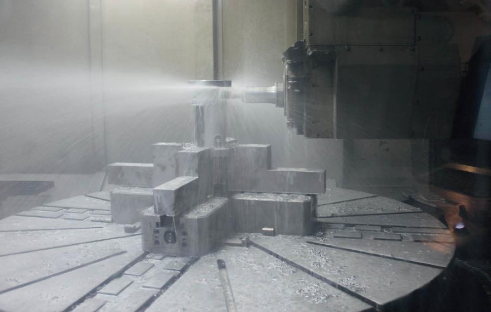Four axis CNC milling
Many standard machines can be upgraded to add a fourth axis that gives you ac-
cess to all sides and the bottom of the workpiece. shows an industrial
milling machine with a rotating machine table that serves as the fourth axis. Rotat-
ing the workpiece enables the operator to remove material from places that are
inaccessible using a 3-axis machine. Additional axes also enable the tool to engage
with the workpiece at a variety of angles. For example, a combination of rotation
and vertical movement can be used to mill threaded parts.

The more robust the material of the workpiece, the stronger the machine has to be
and the smaller the amounts of material that can be removed during a cut. To re-
move material, the machine applies force to the workpiece, and an equivalent
opposing force is created within the machine. This opposing force can potentially
bend or twist the machine itself, which in turn moves the workpiece away from its
intended position, causing deviations in the dimensions of the finished part. If
these deviations (usually called “deflections”) are too large, the finished part may
be unusable.
Engineering machining tolerances are often as little as ±0.01 mm, sometimes
even less. This means that the machine itself has to be stiff enough to prevent flex
or torsion-based effects that exceed ±0.01 mm. These tolerances also apply to the
tool and the mechanisms used to clamp the workpiece. To ensure that these toler-
ances are not exceeded, you have to use either an extremely precisely constructed
machine or work slowly to avoid producing excessive force. Machines that work
fast using a lot of force use precision-made steel parts and are accordingly heavy
and expensive. Most home users don’t have the facilities to accommodate such a
machine and usually end up using a simpler gantry-style machine. Many hobbyists
even build their own.